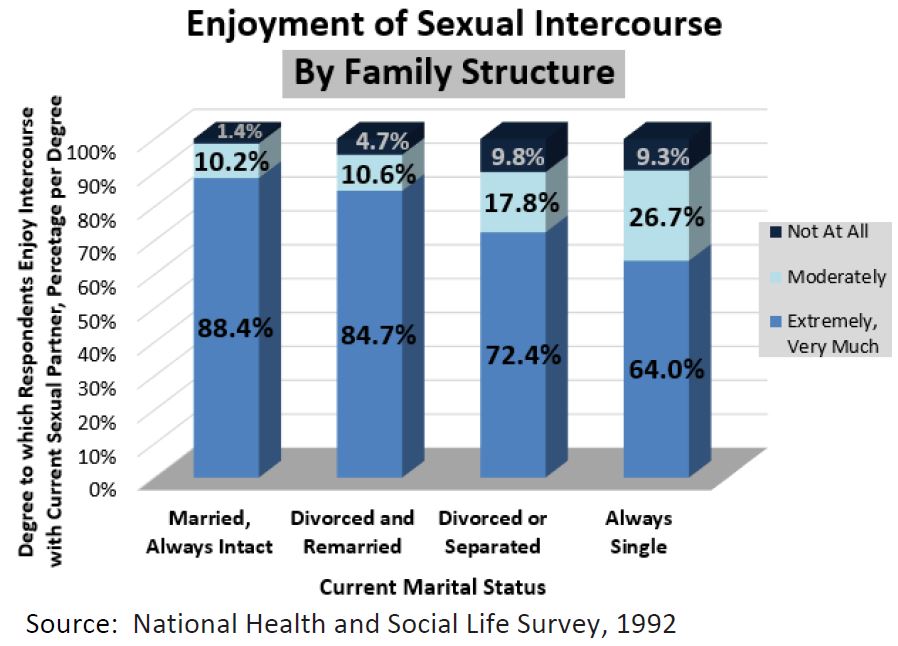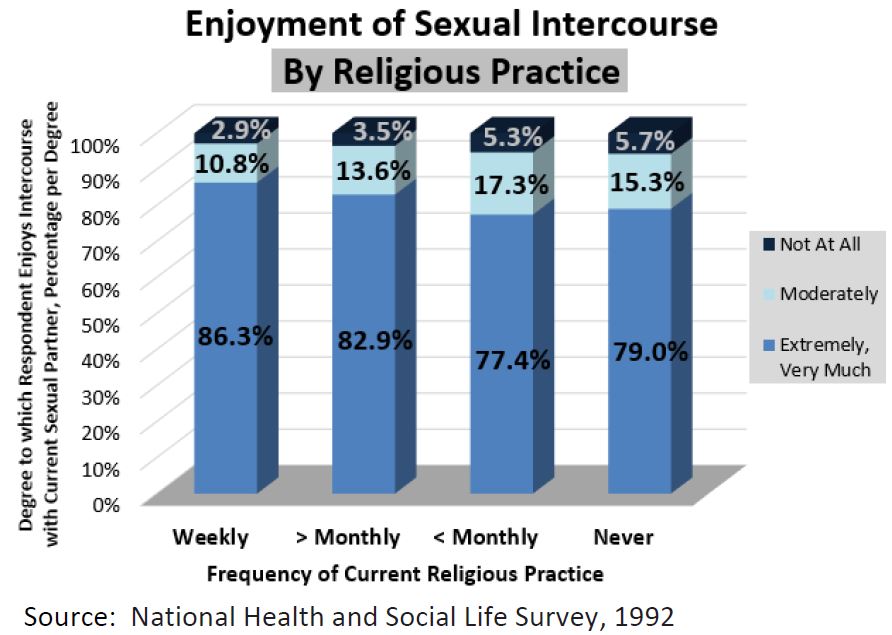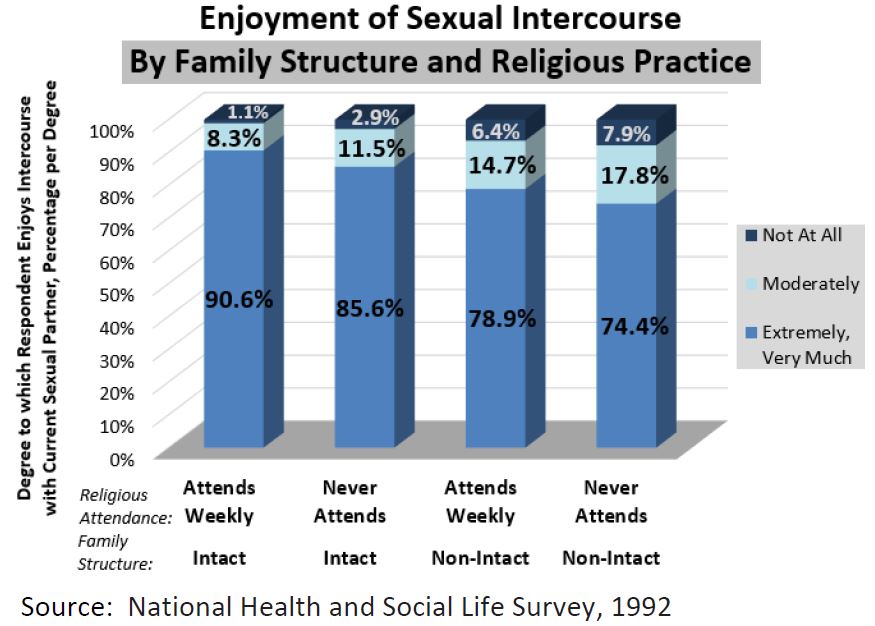Click Here to download “Enjoyment of Sexual Intercourse by Family Structure and Religious Practice”
Enjoyment of Sexual Intercourse by Family Structure and Religious Practice
Adults aged 18 to 59 in intact marriages who worshiped weekly were most likely to report enjoying intercourse “extremely” or “very” much with their current sexual partner, according to the National Health and Social Life Survey (1992), the most detailed analysis of sexual behavior in America. [1] Family Structure: Those in always-intact marriages had the largest percentage of persons reporting that they “extremely” or “very” much enjoyed intercourse with their current sexual partner (88.4 percent). This enjoyment decreased in non-intact structures and among singles: 84.7 percent of those who were divorced and remarried; 72.4 percent of those who were divorced or separated; 64 percent of those who were always single report “extremely” or “very” much enjoying intercourse with their current sexual partner. Religious Practice: Those who worshiped weekly were most likely to report that they “extremely” or “very” much enjoyed intercourse with their current sexual partner (86.3 percent). As worship decreased, so did a couple’s enjoyment of intercourse: 82.9 percent of those who worshiped less than weekly but at least monthly; 79 percent of those who never worshiped; 77.4 percent of those who worshiped less than monthly reported enjoying “extremely” or “very” much enjoying intercourse with their current partner.
Religious Practice: Those who worshiped weekly were most likely to report that they “extremely” or “very” much enjoyed intercourse with their current sexual partner (86.3 percent). As worship decreased, so did a couple’s enjoyment of intercourse: 82.9 percent of those who worshiped less than weekly but at least monthly; 79 percent of those who never worshiped; 77.4 percent of those who worshiped less than monthly reported enjoying “extremely” or “very” much enjoying intercourse with their current partner.
 Family Structure and Religious Practice Combined: Those who were in intact marriages and worshiped weekly were most likely to report that they “extremely” or “very” much enjoyed intercourse with their current sexual partner (90.6 percent), followed by those in intact marriages who never worshiped (85.6 percent), those in non-intact family structures or who were single and who worshiped weekly (78.9 percent), and those in non-intact family structures or who were single and who never worshiped (74.4 percent).
Family Structure and Religious Practice Combined: Those who were in intact marriages and worshiped weekly were most likely to report that they “extremely” or “very” much enjoyed intercourse with their current sexual partner (90.6 percent), followed by those in intact marriages who never worshiped (85.6 percent), those in non-intact family structures or who were single and who worshiped weekly (78.9 percent), and those in non-intact family structures or who were single and who never worshiped (74.4 percent).
 Related Insights from Other Studies: One survey of 797 married men and women found that sexual satisfaction within their marriages was not linked just to their sexual interactions but was strongly associated with the other nonsexual aspects of their relationship as well. These included the couple’s religious life, mutual participation in recreational activities, and the sharing of thoughts, dreams and feelings.[2]
Another study examined the link between religiosity and sexual gratification in the middle years of marriage and found that even where sexual gratification may be lacking, religiosity reduced the impact of the lack of sexual gratification on overall marital satisfaction.[3]
[1] These charts draw on data collected by the 1992 National Health and Social Life Survey
[2] Michael Young, George Denny, Raffy Luquis, and Tamera Young, “Correlates of Sexual Satisfaction in Marriage,” Canadian Journal of Human Sexuality 7, no. 2 (1998): 116, 120.
[3] Paul Wallin, “Religiosity, Sexual Gratification, and Marital Satisfaction in the Middle Years of Marriage,” Journal of Social Forces 42, no. 3 (1964): 303-309.]]>
Related Insights from Other Studies: One survey of 797 married men and women found that sexual satisfaction within their marriages was not linked just to their sexual interactions but was strongly associated with the other nonsexual aspects of their relationship as well. These included the couple’s religious life, mutual participation in recreational activities, and the sharing of thoughts, dreams and feelings.[2]
Another study examined the link between religiosity and sexual gratification in the middle years of marriage and found that even where sexual gratification may be lacking, religiosity reduced the impact of the lack of sexual gratification on overall marital satisfaction.[3]
[1] These charts draw on data collected by the 1992 National Health and Social Life Survey
[2] Michael Young, George Denny, Raffy Luquis, and Tamera Young, “Correlates of Sexual Satisfaction in Marriage,” Canadian Journal of Human Sexuality 7, no. 2 (1998): 116, 120.
[3] Paul Wallin, “Religiosity, Sexual Gratification, and Marital Satisfaction in the Middle Years of Marriage,” Journal of Social Forces 42, no. 3 (1964): 303-309.]]>
